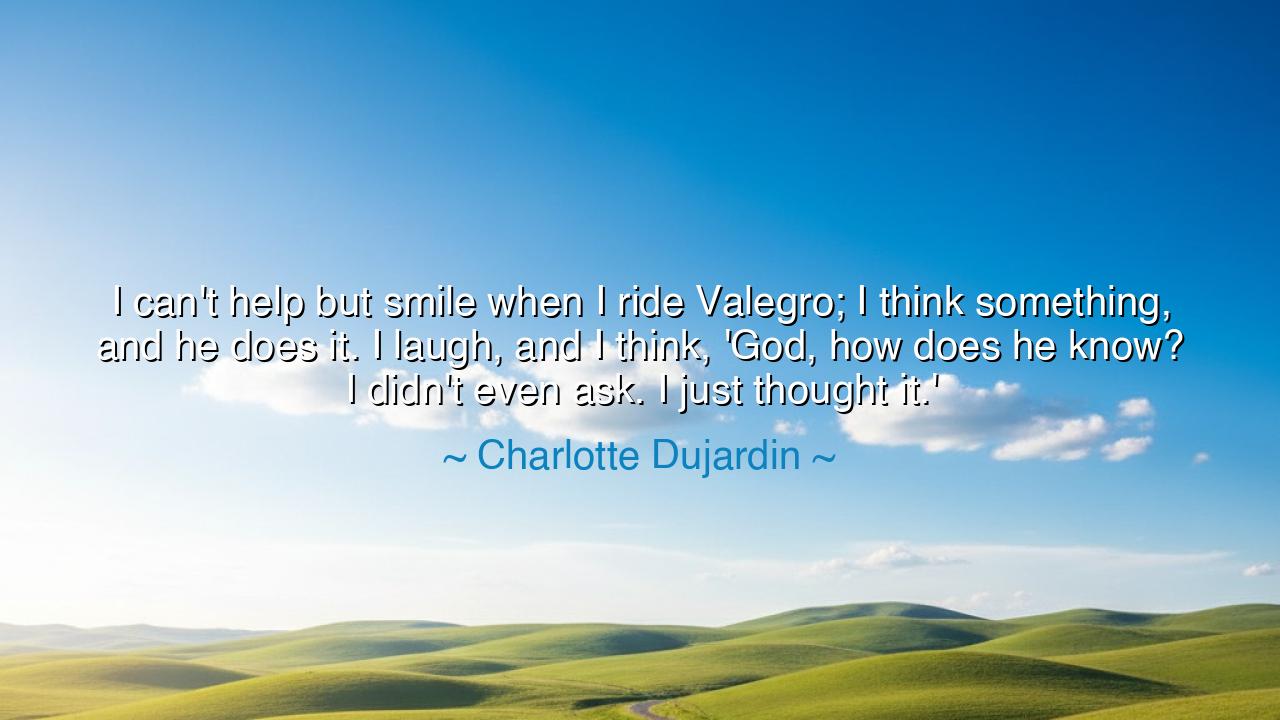
I can't help but smile when I ride Valegro; I think something
I can't help but smile when I ride Valegro; I think something, and he does it. I laugh, and I think, 'God, how does he know? I didn't even ask. I just thought it.'






Hear now, O listener, the words of Charlotte Dujardin, master equestrienne and bearer of Olympic honor: “I can’t help but smile when I ride Valegro; I think something, and he does it. I laugh, and I think, ‘God, how does he know? I didn’t even ask. I just thought it.’” Within this exclamation lies a truth older than kingdoms: the sacred bond between human and animal, between thought and action, between trust and perfect unity.
The meaning of this saying is not merely about horse and rider, but about harmony so complete that it transcends language. Dujardin speaks of a partnership in which thought alone seems to guide motion, where the unspoken is understood, and where joy is the natural outcome. This is no ordinary obedience, no mechanical response, but a communion—a meeting of spirits that moves both to smile and laugh. It is the ancient ideal of unity: two beings acting as one, with no force, no demand, only understanding.
The origin of such wisdom belongs to the oldest of human traditions, for horses have been companions, allies, and partners since before history was written. In the tales of the steppe riders, in the myths of Alexander the Great and his horse Bucephalus, we hear the same reverence: the horse that responds not to the whip but to the heart, the mount that knows its rider’s mind before command is spoken. Valegro, in Dujardin’s words, is heir to this lineage, a creature whose bond with its rider lifts both into the realm of legend.
History offers us clear reflection in Alexander himself, who, as a boy, tamed Bucephalus when no other could. Where others saw a wild, ungovernable beast, Alexander saw fear—fear of its own shadow. By turning the horse toward the sun, he won its trust, and from that day, the two were inseparable. On Bucephalus, Alexander conquered lands, but more than that, he embodied the truth that mastery is not domination, but understanding. So too with Charlotte and Valegro: not conquest, but communion, is the secret of greatness.
This quote also teaches us about the power of joy in mastery. For many imagine greatness as struggle, sweat, and stern command. Yet Dujardin speaks not of effort but of smiling, of laughing, of marveling at the bond itself. True mastery does not weigh heavy on the soul—it frees it. When one is so attuned to their craft or companion that thought flows seamlessly into action, joy becomes the natural companion of excellence. This is the ancient ideal described by philosophers: the merging of mind, body, and spirit into effortless expression.
Practically, the lesson is profound. Whatever your path—be it art, sport, or the daily labors of life—strive for connection, not control. Build trust, whether with people or with the tools of your craft, until action feels like thought itself. Approach your work with love and humility, and you will find that joy blossoms naturally. Seek to smile and laugh in your journey, not only in your triumph, for it is in joy that true greatness takes root.
O listener, take this teaching deep: the bond between Charlotte and Valegro is a mirror to our own pursuits. It is proof that greatness is not solitary but shared, not born of force but of harmony. It reminds us that the most profound achievements are not those we wrest from the world, but those that arise when we walk—or ride—in perfect unity with another soul.
So remember this: when your thoughts flow into action without effort, when your heart is met by another’s understanding, when your work becomes a source of smiles and laughter, then you have touched the divine harmony that the ancients called excellence. Cherish it, nurture it, and let it guide you, for it is in such moments that life shines with its purest light.






AAdministratorAdministrator
Welcome, honored guests. Please leave a comment, we will respond soon